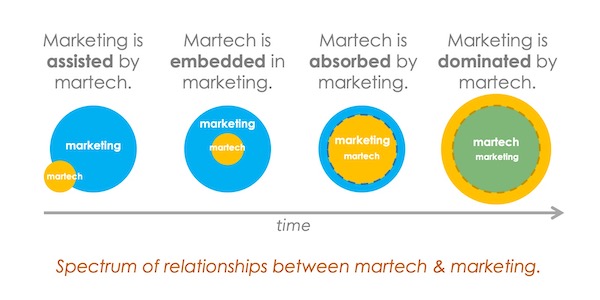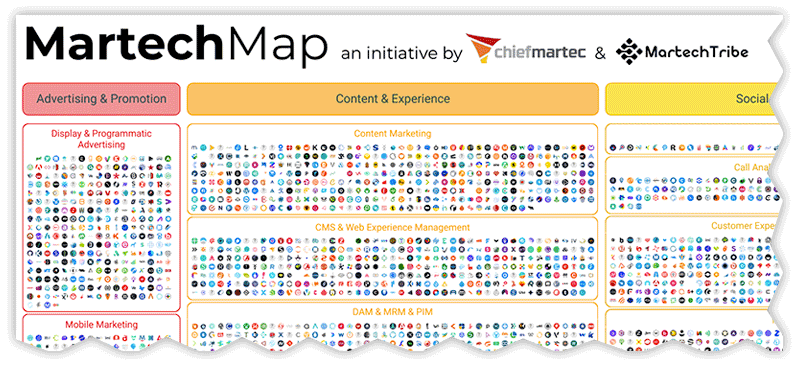Marketing technology, or martech, is quickly becoming the backbone of online marketing. It’s one of the fastest-growing industries in the global market. Unfortunately, rapid growth brings growing pains with it.
In marketing, this means marketers and agencies may struggle to find and bring in the right tech, at the right time, and with minimal adoption periods. The growth rate makes it very tough to adjust and compete.
For context, here’s what the global martech growth numbers look like:
- Martech makes up 26.2% of total marketing budgets in 2022
- The martech landscape has seen a 5,233% growth in vendor numbers
- The global martech market is currently valued at $344.8 billion.
With the rate that technology is transforming marketing, it can be tough to decide when to adopt new marketing tech, how to adopt it, and if you even need to adopt it.
To help you make more informed decisions, here’s a brief guide to keeping up with rapid changes and progress in marketing technology.
Why Adopt New Marketing Technology? [An Overview]

Image via ChiefMartec
Technology helps streamline almost every aspect of online marketing.
From coming up with new ideas to repurposing high-performing assets, to high-level content modeling, martech simplifies otherwise complex processes.
Here are some of the major advantages of martech today:
- Marketing and content automation helps reach complex content and outreach goals
- Smart tech ecosystems let you focus on creativity over standard marketing operations
- Modern data management tools help you collect, process, and manage data much more efficiently
- Most martech systems can be customized to your team’s needs
- Technology lets marketing teams create sustainable growth.
In short, marketing technology is the logical step for companies and agencies looking to compete in 2022 and beyond.
How to Bring in New Marketing Technology [5 Simple Steps]

Image via ChiefMartech
Depending on your individual marketing needs, you’ll have specific short, medium, and long-term requirements for marketing tech.
These needs will determine when and how you need to bring new martech into your marketing fabric.
Here’s a step-by-step guide to adopting marketing technology the right way.
Step 1. Analyze Your Marketing Requirements
As mentioned, your requirements will be very specific to your current and future needs.
Analyzing your marketing requirements is a vital first step because it has three major benefits:
- Save time that would otherwise be spent on adoption and training
- Cut downtime caused by the adoption process
- Save money on subscriptions
Basically, it prevents you from wasting effort on tech you don’t really need at that specific point.
The best way to analyze your marketing requirements is to look at your standard client and deliverables.
Ask yourself these questions:
- Are you getting work on an increasingly bigger scale?
- Have your clients asked for improvements in delivery time?
- Do any new tools have the capabilities you’re looking for to improve quality and delivery time?
If your answer is yes to all of these questions, your marketing teams can probably benefit from new tech. However, if you’re doing pretty well and can improve by simply streamlining existing processes, you’re better off waiting to adopt.
Step 2. Compare New Technology via Case Studies and Reviews
As you start delving into research on different solutions, seek out videos and user reviews that help you quickly cancel out a ton of trial and error on your part. Additionally, you’ll discover details about each new tool that may help you make a much more informed adoption decision.
The best way to find credible reviews is to look on software review aggregator sites like G2 and Capterra.
These sites have many reviewers posting all kinds of reviews, from surface-level to more detailed ones. You can even find some great use cases from users who are in a similar position or type of company.
Although case studies are subject to a lot of variables, they can be highly beneficial when it comes to software. Since most modern marketing and media asset management software systems are built with common marketing channels in mind (web, email, social, video, etc.), chances are high that you’ll find commonalities within most case studies.
Step 3. Follow Major Martech Influencers
Follow the major information providers in the industry to keep up with recent developments.
The best thing about following major marketing influencers is that you get insights not only into martech but marketing in general. These influencers break down what’s happening in the greater digital marketing world and explain which software is beneficial for which marketing-related functionality.
One thing you should keep in mind is that influencers often will push software they have a vested interest in. This may result in them giving glowing reviews for specific tools and software.
To weed out biased reviews, look for influencers who:
- Give the most objective insights
- Are transparent about their relationship with certain vendors
- Highlight software shortcomings instead of just their advantages.
Generally speaking, it’s smart to listen to a range of voices from software enthusists to actual users.
Step 4. Get Internal Buy-In
Make sure everyone who will use the technology is on board with its implementation.
For example, if you’re a marketing agency looking to integrate digital signage software, everyone who will interact with the software at some point should get a say. This early visibility will help you have faster adoption of the software later on.
Internal buy-in ensures that teams are willing to shift from their current preferred software to the new technology.
In addition to the above, full buy-in is necessary because of the disruptive nature of most modern marketing software.
Most CRMs, content marketing platforms, analytics tools, and SEO software are designed to take over existing marketing frameworks. Your team members need to be comfortable with dropping a system they’ve been using and learning a whole new system.
Step 5. Provide In-Depth Training
Lastly, train your marketers consistently and with hands-on workshops.
User training is usually a value-add since most software tools come with detailed tutorials. However, it’s a good idea to have brief training sessions on an ongoing basis. These training will help get comfortable in the systems much quicker than they would with video tutorials alone.
The amount of training your marketing team needs will depend on the scale of the technology you’re adopting. If you want to replace your CRM with a new, smarter one that has automation features, you’ll probably need a break-in period.
However, if it’s simply an internal communications system, you can continue your operations without delay. Keep that in mind when implementing training periods.
Final Thoughts
No matter how overwhelming it may seem, full martech integration is the future of marketing.
Martech will continue to grow and replace current frameworks to a point where most marketing functions are either automated or performed by smart AI.
Considering that, it makes sense to have an all-encompassing content marketing aide such as DivvyHQ within your marketing framework.
As is clear by now, implementing user-friendly marketing tech is the way to go for modern marketing teams. And DivvyHQ is designed specifically with modern, enterprise marketing and communications teams in mind. Try it free for 14 days and see for yourself!